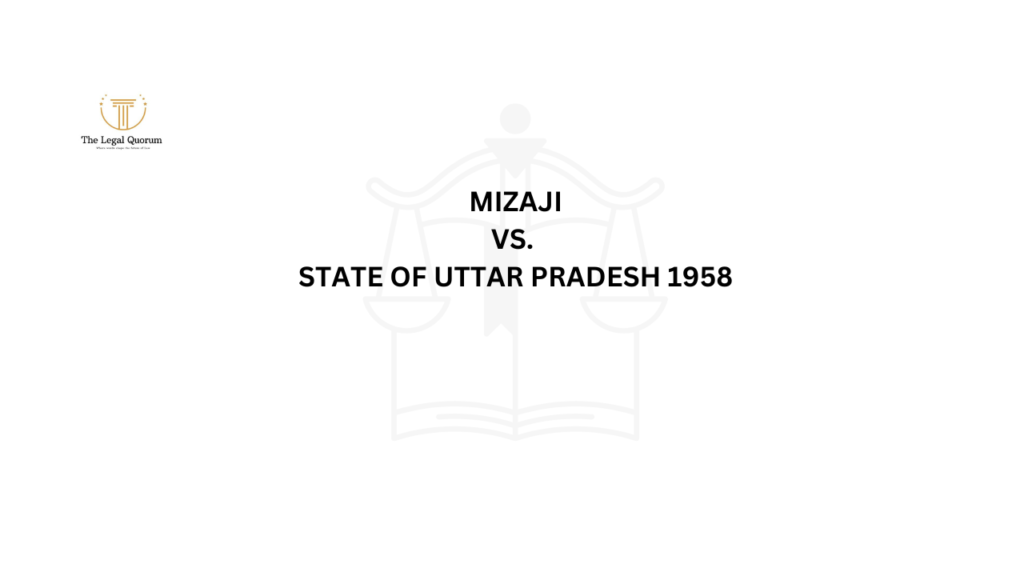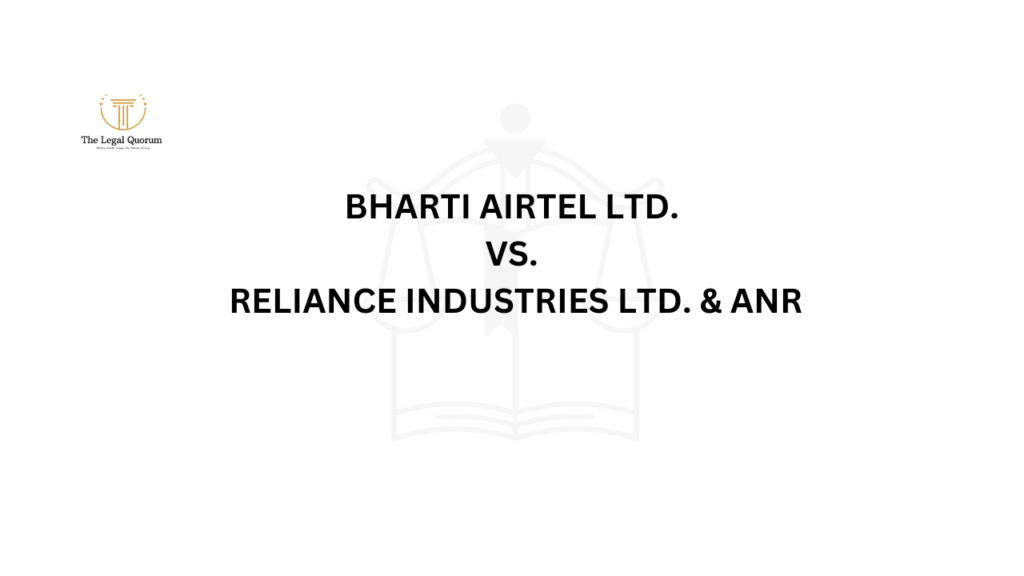Published on 1st July 2025
Authored By: Mahi Srivastava
VIPS-TC
INTRODUCTION
The Supreme Court in this case reaffirmed the social welfare objective of Section 125 of CRPC, emphasizing that the provision is not meant to punish or deteriorate any marriage but to protect vulnerable sections, especially women and children from financial destitution. It manifested the idea of Justice and Equity which demands that a woman who cohabited in good faith, bore a child, and was treated as a wife, should not be deprived of the basic sustenance.
FACTS OF THE CASE:
Appellant no 1 before the court – SMT Usha Rani married Nomula Srinivas on 30th August 1999 at Hyderabad. They had a son during their marriage as Sai Ganesh born on 15th August 2000. The child was brought up by both of them until some differences came between them. After returning from United States of America in February 2005, the couple began living separately from each other because of differences which could not be reconciled and later on, the Memorandum of Understanding (MoU) terminating their marriage relationship was executed. But no formal legal divorce order was obtained.
On 27th November 2005, the Appellant married the respondent by the name Moodudula Srinivas with the full knowledge that she had been married before. The respondent subsequently filed a petition for a formal declaration that her 1st marriage was null and void. He asserted this under section 12 of Hindu marriage act 1956 read with section 7 of Family courts Act 1984.
The Family Court in Hyderabad received the petition and issued a decree on 1st February 2006 making the first marriage of the appellant null and void.
In spite of making this declaration, on 14th February 2006, appellant and respondent got married again and had their marriage registered with the Hyderabad Registrar of Marriage on 11th September 2006.
The couple soon had a daughter, Venkata Harshini, on 28th January 2008. In spite of this, the relationship between the couple turned into domestic harassment and abuse.
The appellant subsequently lodged a complaint against the respondent and his family members under section 498A,406,506, and 420 of Indian Penal Code and Section 3 and 4 of Dowry Prohibition Act, 1961.
After they got separated, the appellant made an application for maintenance under Section 125 of the Cr.P.C. The Family Court of Hyderabad granted Rs. 3500 per month to the appellant and Rs. 5000 per month to the minor daughter, Venkata Harshini. Respondent filed a criminal revision petition against the grant of maintenance.
KEY ISSUES INVOLVED IN THE CASE:
1) Was the appellant entitled to maintenance even if there was no formal divorce from her first husband?
2) Is a second husband liable to pay maintenance even if the marriage is void?
3) Is a woman in a void marriage a ‘wife’ under Section 125 Cr.P.C.?
4) Does the lack of a formal divorce impact the claim for maintenance?
DECISION OF THE FAMILY COURT:
The family Court while deciding the maintenance of the appellant laid stress on the point that even after the first marriage was annulled, they had got remarried and cohabited as husband and wife, they even got a child which makes the appellant’s status dependent.
Accordingly, the court held that respondent was liable to provide the monetary assistance under Section 125 of CRPC[1] as he had fulfilled all marital obligations as well as rituals. Decision by the High Court of Karnataka:
the High Court upheld the award of maintenance in favor of the daughter i.e., Appellant No. 2 but rejected the award of maintenance in favor of the Appellant No. 1, The major rationale of the court was based upon the legal legality of the marriage between the appellant and the respondent. It was submitted that Appellant No. 1 cannot be regarded as the legal wife of the Respondent since her previous marriage to Nomula Srinivas was not terminated by way of a decree of law.
CONTENTIONS OF THE APPELLANT:
It was contended by the appellants through the Learned Counsel that Appellant No. 1, having lived with the respondent as de facto wife and brought up a child with him, must be given maintenance. They were dependent on the Supreme Court ruling in Rameshchandra Rampratapji Daga vs. Rameshwari Rameshchandra Daga (2005)[2], in which maintenance was awarded under Section 25 of the Hindu Marriage Act (HMA)[3] to a woman even though her first marriage remained legally binding, based on customary divorce and revelation of her marital status to the second husband.
They also referred to Chanmuniya vs. Virendra Kumar Singh Kushwaha (2011)[4], in which the Court stressed that Section 125 CrPC must be construed liberally to cover live-in relationships, contending that men cannot shirk responsibilities by taking advantage of legal technicalities in de facto marriages.
CONTENTIONS OF THE RESPONDENT:
The respondent’s advocate was against awarding maintenance to Appellant No. 1, contending that she cannot be treated as a “wife” under Section 125 CrPC. They based themselves on the Supreme Court ruling in Savitaben Somabhai Bhatiya vs. State of Gujarat (2005)[5], in which maintenance was refused to a second wife since the first marriage of the husband remained legally valid. The Court ruled that the term “wife” cannot be interpreted to cover a woman who is not legally married, even if the husband regarded her as a wife or kept his first marriage secret. In the same manner, as Appellant No. 1’s first marriage continued to exist, she is not entitled to claim maintenance from the respondent.
DECISION OF THE SUPREME COURT:
The Supreme Court reversed the High Court’s decision and reinstated the Family Court order for maintenance on behalf of a woman whose second marriage was legally null and void because she did not obtain a proper divorce from her first husband. The Court acknowledged the de facto separation of the appellant from her first husband, supported by a Memorandum of Understanding. As she did not get any financial maintenance from her first marriage, the Court held her entitled to maintenance under Section 125 Cr.P.C. The respondent, being well aware of the first marriage of the appellant, willingly entered into a relationship with her. The Court held that admitting him to a denial of maintenance would go against the very purpose of Section 125 Cr.P.C., an amenability legislation aimed to check destitution. The court reemphasized that legalities like a decree for divorce need not stand in the way of the actual intent behind maintenance law—preventing destitute women from financial disintegration.
It focuses on 4 key issues;
Legal Issue 1: Entitlement to Maintenance Though No Formal Divorce
It was held that the maintenance should be awarded.
Analysis:
- The Supreme Court had a purposive view of Section 125 Cr.P.C., reading the statute keeping in view the social welfare intention—to prevent destitution among women.
- De facto separation was accepted as enough by the Court, particularly if financial support wasn’t being generated from the previous spouse.
- Memorandum of Understanding (MoU) with the appellant and her initial husband was treated as proof of separation, albeit without a formal divorce.
- It was established that adhering strictly to the law would negate the intent of the provision and deny protection to vulnerable women.
It was quoted that “Appellant No. 1 is not receiving maintenance from her first husband de facto separated. Thus, except in the absence of a legal decree.”
Legal Issue 2: Maintenance Liability in Void Marriage
It was held that the second husband is liable even if marriage is void.
Analysis:
- The Court stressed that awareness of the prior marriage is crucial. The respondent knew perfectly well about the appellant’s prior marital life yet went ahead and entered into a relationship with her. Following principles of Badshah v. Urmila Badshah Godse[6] and Chanmuniya v. Virendra[7], the Court argued that, laws relating to maintenance should be construed liberally and in a beneficial sense. Refusal of maintenance in such situations would be an encouragement to fraudulent behaviour and would allow exploitation. The duty to maintain does not disappear just because of technical invalidity of the marriage if it was contracted in good faith or with knowledge.
As Quoted by the judges: “to allow a constructive interpretation. is required to stop vagrancy and destitution. and to prevent giving judicial approval to the Respondent’s flight from duty.”
Legal Issue 3: Is a Woman in a Void Marriage a “Wife”?
- The definition of “wife” in Section 125 Cr.P.C. has been judicially extended in earlier precedents to cover women in void or irregular marriages, particularly when they were unaware of legal hurdles and where the husband was in complete knowledge, as here.
- The decision relied substantially upon Chanmuniya and Rameshchandra Daga, both of which upheld maintenance when the relationship had signs of marriage and the woman was economically in a dependent position.
There are some differences from Previous Cases:
- Yamunabai v. Anantrao and Bakulabai v. Gangaram[8] were distinguished as in those, there was no claim or evidence of separation from an earlier subsisting marriage or knowledge on the part of the second husband.
Legal Issue 4: Effect of Lack of Formal Divorce on Maintenance Claim
It was held that the lack of formal divorce does not repel a maintenance claim.
- The Supreme Court held that formal legal processes, such as a decree of divorce, cannot supersede the actual life economic and social vulnerabilities of women. The Section 125 Cr.P.C. was drafted as a sheltering, and not penal law and cannot be utilized to penalize a woman for procedural defects when the separation is manifest, she is economically dependent and the man joined the relationship with full awareness.
CONCLUSION:
Section 125 of the Criminal Procedure Code is intended to have a social function—it seeks to prevent women from becoming destitute or homeless by ensuring that they get minimum aid such as food, clothes, and shelter if they have been left behind by their husband. This section provides an immediate and efficient legal relief for such women.
If a husband attempts to evade providing maintenance by stating that his wife is merely a “kept mistress” and asserts that he was already married when he wedded her, then the courts demand forceful and evident evidence that the previous marriage was valid and still ongoing.
The law itself defines “wife” in a wider sense under Section 125. It encompasses:
- A woman divorced by her husband, or
- A divorced woman who has not remarried.
Thus, the law protects divorced women as well, since that serves the purpose of avoiding poverty and neglect.
But if a woman is in a second marriage which is not legal because the first marriage of the man is still in force, then she is not a legal wife and generally cannot receive maintenance under this law.
But there’s a catch—this rule holds only if the man can clearly prove that his first marriage was still valid at the time of the second one. That’s because this law is a protection law, not a technical law. It’s about justice and equity, particularly for women and children.
In the case at hand, the man could not produce concrete evidence that his initial marriage was valid and subsisting. The High Court bypassed this condition and erroneously ruled the case against the woman, without concrete evidence.
Thus, the Supreme Court disapproved of the High Court’s ruling and held that the woman is eligible to get maintenance under Section 125.
REFERENCES
[1] § 125, Code of Criminal Procedure, No. 2 of 1974, INDIA CODE (1974).
[2] Rameshchandra Rampratapji Daga vs. Rameshwari Rameshchandra Daga (2005) 2 SCC 33.
[3] § 25, Hindu Marriage Act, No. 25 of 1955, INDIA CODE (1955)
[4] Chanmuniya vs. Virendra Kumar Singh Kushwaha (2011) 1 SCC 141.
[5] Savitaben Somabhai Bhatiya vs. State of Gujarat (2005) 3 SCC 636.
[6]Badshah v. Urmila Badshah Godse (2014) 1 SCC 188.
[7] Chanmuniya v. Virendra (2011) 1 SCC 141.
[8] Yamunabai v. Anantrao and Bakulabai v. Gangaram (1988) 1 SCC 530.




